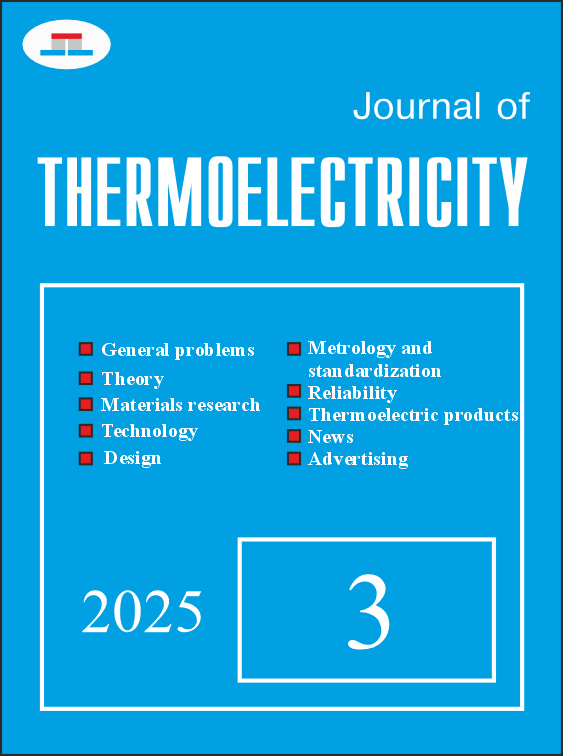Features of Structural, Energetic and Electrokinetic Properties of Semiconductor Thermoelectric Material TiNi1-xAgxSn
DOI:
https://doi.org/10.63527/1607-8829-2025-3-18-28Keywords:
thermoelectric material, thermoelectric figure of merit, electronic structure, electrical resistivity, thermopower coefficientAbstract
The structural, electrokinetic, and energetic properties of the semiconductor thermoelectric material TiNi1-xAgxSn, obtained by doping the TiNiSn compound with Ag atoms, were investigated. The nature of the generated energy states and mechanisms of electrical conductivity were established. It was shown that at various concentrations, Ag atoms (3d105s1) can occupy different crystallographic positions, generating structural defects of both acceptor and donor nature. At concentrations of TiNi1-xAgxSn, х=0–0.02, Ag atoms predominantly replace Sn atoms (4d105s25p2) in the 4c position, generating acceptor states εАAg(Sn) in the band gap eg. At higher concentrations, х˃0.02, Ag atoms replace Ni atoms (3d84s2) in the 4d position, generating structural defects of donor nature and the corresponding energy states εDAg(Ni). The ratio of the concentrations of the generated donors and acceptors determines the position of the Fermi level εF. The performed studies allowed us to identify the mechanisms of electrical conductivity to determine the synthesis parameters of the thermoelectric material TiNi1-xAgxSn with the maximum efficiency of converting thermal energy into electrical energy. It is shown that the semiconductor solid solution TiNi1-xAgxSn is a promising thermoelectric material.
References
1. Anatychuk, L. I. (1998). Thermoelectricity. Physics of thermoelectricity (Vol. 1, 376 p.). Institute of Thermoelectricity.
2. Romaka, V. A., Stadnyk, Yu. V., Romaka, V. V., Fruchart, D., Gorelenko, Yu. K., Chekurin, V. F., & Horyn, A. M. (2007). Features of electrical conductivity in the n-ZrNiSn intermetallic semiconductor heavily doped with the In acceptor impurity. Semiconductors, 41(9), 1041–1047. https://doi.org/10.1134/S1063782612070172
3. Roisnel, T., & Rodriguez-Carvajal, J. (2001). WinPLOTR: A windows tool for powder diffraction patterns analysis. Materials Science Forum, 378–381, 118–123. https://doi.org/10.4028/www.scientific.net/MSF.378-381.118
4. Schruter, M., Ebert, H., Akai, H., Entel, P., Hoffmann, E., & Reddy, G. G. (1995). First-principles investigations of atomic disorder effects on magnetic and structural instabilities in transition-metal alloys. Physical Review B, 52(1), 188–209. https://doi.org/10.1103/PhysRevB.52.188
5. Moruzzi, V. L., Janak, J. F., & Williams, A. R. (1978). Calculated electronic properties of metals (348 p.). Pergamon Press. https://doi.org/10.1016/B978-0-08-022705-4.50002-8
6. Marazza, R., Ferro, R., & Rambaldi, G. (1975). Some phases in ternary alloys of titanium, zirconium, and hafnium, with a MgAgAs or AlCu₂Mn type structure. Journal of the Less Common Metals, 39, 341–345. https://doi.org/10.1016/0022-5088(75)90207-6
7. Romaka, V. A., Rogl, P., Romaka, V. V., Hlil, E. K., Stadnyk, Yu. V., & Budgerak, S. M. (2011). Features of a priori heavy doping of the n-TiNiSn intermetallic semiconductor. Semiconductors, 45(7), 879–885. https://doi.org/10.1134/S1063782611070190
8. Shklovskii, B. I., & Efros, A. L. (1984). Electronic properties of doped semiconductors (388 p.). Springer-Verlag. https://doi.org/10.1007/978-3-662-02403-4
9. Mott, N. F., & Davis, E. A. (2012). Electron processes in non-crystalline materials (590 p.). Clarendon Press. https://doi.org/10.1002/crat.19720070420
10. Romaka, V. A., Stadnyk, Yu. V., Akselrud, L. G., Romaka, V. V., Fruchart, D., Rogl, P., Davydov, V. N., & Gorelenko, Yu. K. (2008). Mechanism of local amorphization of a heavily doped Ti₁₋ₓVₓCoSb intermetallic semiconductor. Semiconductors, 42(7), 753–760. https://doi.org/10.1134/S1063782608070014




